Calling vs. Emailing
In today’s business world, we live and work in a sea of emails, instant messages, text messages, and collaboration platforms. With this it’s easy to get caught up in the digital shuffle—sometimes you just need to go analog.
Why go analog in a digital world?
People like to work with people: try to create a personal connection whenever possible. This could mean a phone call, or even better, a video call—especially if the topic is sensitive or complex, meaning it could take multiple emails back and forth to get to a solution.
If you find yourself thinking that the message you’re about to send is going to confuse or frustrate a client (or anyone for that matter), or they’ve previously expressed confusion or frustration with emails, then it may be best to take the time to pick up the phone and call. It could save you time and show the client you’re conscious of their time.
Practice Calling vs. Emailing Clients
The next time you’re about to send that super long email, try shooting a quick note first asking the client to chat. Let them know you’re about to send them a long message and you wanted to discuss in advance to avoid any potential confusion.
Start off by saying something like “Rather than going back and forth on email, I figured we could have a quick conversation to keep things moving”. Once you have had your conversation, then send a summary follow up email confirming the conversation and sharing next steps.
Practice Calling vs. Emailing Coworkers
We’ve all been on those never-ending internal email threads: you know, those emails that could be solved much more quickly if we just chatted face-to-face. Rather than letting those email threads drag on, take a moment to get out of your seat (yep, stand up) and walk over to your colleague’s desk to discuss in person. If your coworker is remote, shoot them a quick note to talk on the phone or a video chat.
If you have the opportunity, try to save everyone an extra series of emails (and time) by taking conversations to the phone, video chat, or even in person whenever possible, then use email to recap and document next steps.
How to Manage a Talkative Client
Should you ever interrupt a client?
Many of us have probably found ourselves in the presence of long-winded clients. It can be challenging to identify when and how to interrupt them in order to keep the conversation moving along, especially when you’ve got limited time during scheduled meetings.
And then there’s the internal struggle of interruption coming off as rude vs. keeping the conversation moving. Especially when long-winded clients often end up offering much more information about their business, goals, challenges etc. without even being prompted during these times.
This delicate balance of being polite vs. getting stuff done can create an uneven canvas to work with. So, here are some pointers on how to identify when interruption could be okay (usually never by the way), along with questions to ask that will keep the conversation moving:
- Is there a natural pause coming up where I/we can pivot the conversation?
- If yes, then wait. If no, see questions below to keep the conversation moving.
- Is the rambling part of a story/example answering a previous topic or question?
-
- If yes, then wait. If no, see questions below to keep the conversation moving.
- Is the rambling negatively impacting the business and/or impeding on immediate progress
-
- If yes, let them finish but follow up with probing questions to get at the root of the challenge they’re having. If no, then wait for a natural pause to move the conversation along.
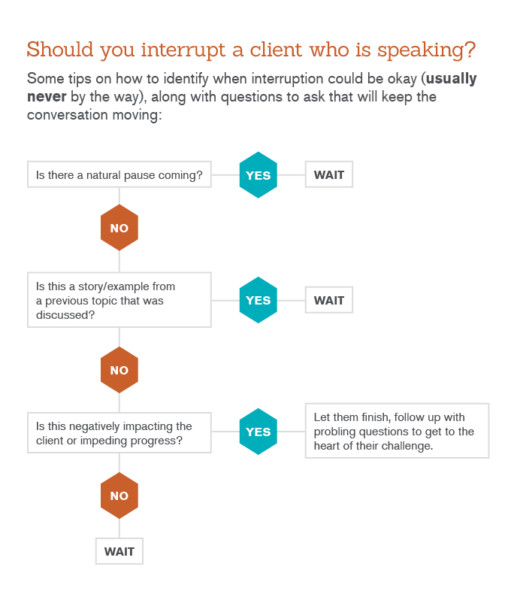
Questions to ask to move the conversation along:
- So, please tell us what finally happens?
- What would you say is the overarching or underlying theme of the issues, examples, challenges you’re describing?
- Of everything you’re sharing, is there anything in particular that is a higher priority for us to focus on during this time?
- Can you please summarize the issue/challenges you’re having in a few sentences?
- May we take a quick timeout, please? We’re hoping to understand how this relates to the goal/issue you want to work on / that we’re meeting about.
- So, how does that make you feel? This is a magical phrase btw. Try it out sometime when talking with clients and see what happens!
- Sounds like this is very important to you. Would you like to focus on this topic now and we can reschedule time to cover other items, or we can revisit this once we get through the other items and if we don’t have enough time, we can always schedule a follow up.
If you do catch yourself in the heat of the moment, eager to contribute, and OOPS! you just talked over your client, don’t sweat it. It’s okay to pause, apologize for the interruption, and invite your client to please continue their thought. If your contribution was critical, simply write it down so you don’t forget to come back to it.
How to Frame Recommendations
It’s critical to frame recommendations for clients in a way that demonstrates quantifiable business impact. Meaning, by implementing this particular recommendation, what will happen to the business? Will we reach a wider audience, save the client money, make the client more money, etc.?
Not only does approaching conversations in this manner show you’re invested in having an impact on the client’s most important goals, it also makes it easier for the client to buy-in to what you’re proposing.
[TIP] Always map recommendations back to business objectives whenever possible.
How to frame client recommendations
Phrases like these should be a regular staple in your communication with clients:
- “We recommend X, because of Y, in order to help you Z.”
- “Data showed us X, which supports/negates your goal to Y, so we recommend Z.”
- “We believe that [some idea]. If we’re right, we will [some action]. To test this, we will [tool/technology/approach].” (credit: Tim Wilson, Analytics Demystified)
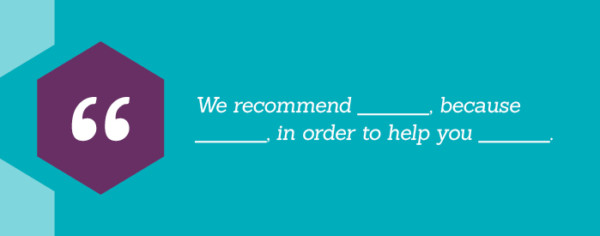
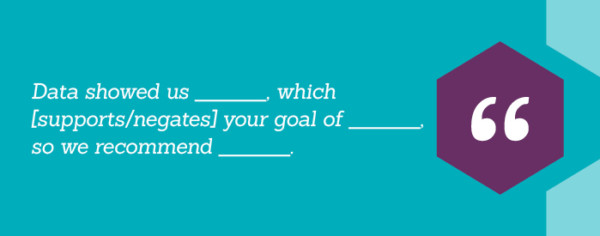
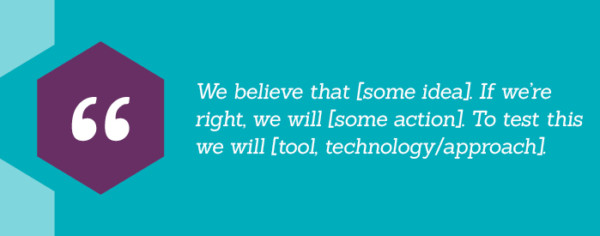
How to Present Multiple Options
If you have multiple approaches on the table and are having trouble getting the client to decide, make a one-sheeter outlining all possibilities. This will concisely propose all potential options, and allow you to consult the client on which you believe to be the best option.
| Approach | Details | Benefit | Risk | Outcome |
| Approach A | ||||
| Approach B | ||||
| Approach C |
Go Beyond the “What”
In addition to framing a message to show impact, it’s also important that you go beyond the static “What”, to include the “So what?” and “What’s next?” By going a step beyond the “what”, we will not only challenge ourselves to think harder, but also become stronger partners for our clients.
Think about it from a client perspective: if someone told you that traffic to your website was up compared to the month prior, what would be your natural follow up question? Most would say: “Why?” followed by a “Great! So what’s next?”.
This goes for the inverse, too. If performance is down, you’d want to know why, and what your consultant is doing about it.
These are the questions running through a client’s mind with every deliverable you send, so it’s helpful to get into the habit of weaving these answers into presentations, emails, and conversations before they’re even asked.
Questions to Ask Yourself Before Making Recommendations
Use these questions as a guide when presenting any sort of information or recommendation to clients:
- What did we do/what are we sending?
- Why are we sending it?
- Where does it fit into the overall strategy and plan?
- For reporting: what changed since the last report? What are we doing/going to do/or did we do about it? And what impact would we anticipate seeing as a result?
By combining an impactful message with clear and actionable details on where and how the update you’re sending fits into the overall picture, you’ll be setting your team and the partnership up for continued success. By taking the time to provide more details up front, you’re anticipating questions (providing answers before they’re asked) as well as consulting on how you believe the client should interpret and use the information.
Client Meeting Prep Checklist
Taking time to prepare for client calls & meetings will help you and your teams make sure you’re getting the most out of the dedicated time together. This tip includes 5 key questions to ask yourself (and/or your team) in order to prepare for a successful meeting or call:
“What’s the purpose of this call/meeting?”
Every meeting, call, conversation should have a purpose (and clear objective). This should also be captured in the invite.
“Is there an agenda? And is it in the calendar invite (or a link to it)?”
Every planned meeting should have an agenda, even if it’s simply something like this. Having an agenda helps ensure everyone in attendance is prepared and focused:
- Review priority items
- Business Updates
- Next Steps
“What is our (agency/consultant) goal for this call/meeting?”
Is there something we want/need to get out of the conversation? If so, make sure you don’t leave without getting that information (or understanding the next steps to get to the end result). Although we’re in a service business (and often catering to client requests/objectives), we are also a business ourselves, so make sure you’re taking the time to get the info you need to do your and your team’s best work.
“Do we have enough time to cover everything?”
If you think there may not be enough time to cover everything, you have a few options:
- Scale back the agenda if you can, possibly separate the conversation into two meetings if more time is needed
- Arrange the agenda by priority – start with the most important things first
- Set expectations at the beginning of the call with something like “We have a lot to cover today, so I’ll/we’ll be keeping time to ensure we stay on track and make the best use of the time we have.)
“Who is leading the call and who is speaking to what?”
Every call should have a ‘call lead’ to help avoid the awkward silence between agenda points / or questions, and keep the conversation moving along based on the agenda. Try to assign a call lead for every client call if possible.
Similarly: identify clear roles for client calls. Who is speaking to what slides and agenda points? Who is fielding questions should they arise? Much of the latter may happen organically, however it will save time (and awkwardness) having clear ‘leaders’ for different elements of a conversation.
It’s a great exercise to actually write these questions out and jot down the answers to create an internal guide before the meeting. You can also review this information as a team before the meeting to make sure everyone is aligned. The additional preparation should help everyone feel confident going into the meeting.
Where to Sit in Meetings
Believe it or not, where you and your clients sit at a table during presentations plays a factor in the conversation flow and room energy.
Most people “allow” clients to sit at the front of the a table closer to the projection screen, or in the middle of a table surrounded by team members. While it may seem welcoming, this type of seating (pushing the client to the front of the room, or dead center among a large team) can often result in clients having to work harder to engage in the full conversation, like they’re watching a tennis match.
Strategically Plan Seating Arrangements
Think about who sits where before everyone takes a seat. In most cases you’ll want whomever is presenting to sit closest to the screen and have the clients in the middle/back. This way they can maintain a forward gaze for the majority of the meeting, while easily maintaining eye contact with presenters and other team members.
Take Control
Most people awkwardly linger around the table before taking a seat in a big meeting, so alleviate that pain and take the lead by recommending seats. Demonstrate your expertise by consulting the seating charts below for your next client presentation. By doing this you’ll start inviting more conversation (partnership) and less “presentation” (vendor).
Meeting Seating Arrangements
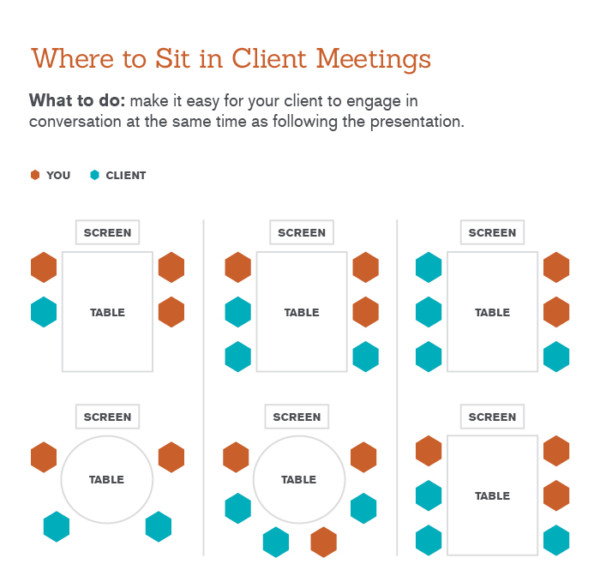
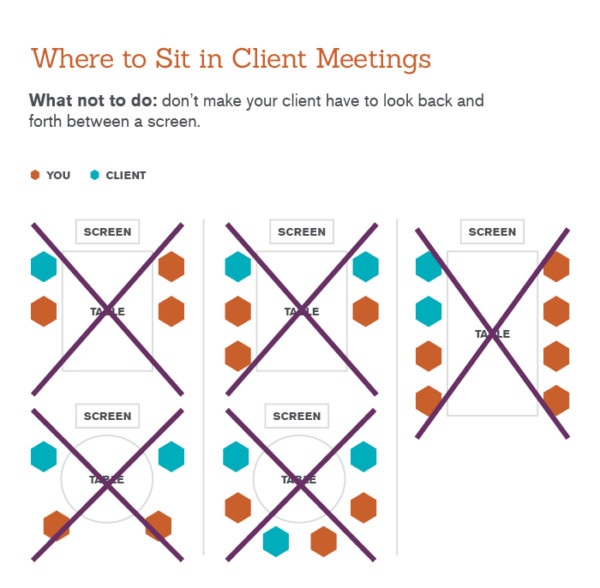
3 Tips for Effective Status Meetings
Have you ever checked in with your client to see if they’re getting value from your regularly scheduled status meetings?
Have you thought about how you could provide more value and be more engaging during those meetings by going beyond a checklist of deliverables and updates?
A client once requested that we move any topics outside of our weekly status that can be answered in an email. Instead, they asked us to put together an alternative agenda to leave more time to brainstorm and provide more thoughtful insights.
Here are a few ways to get a bit more out of status calls:
Focus Only on Priorities
Start the call with a discussion around the clients’ priorities. Priorities are almost guaranteed to be shifting constantly, and it’s important to touch base on what’s changing within their organization in the near future. Keep in mind that they may forget to update you if and as priorities shift, so it’s always a good idea to check in.
After understanding their priorities, do any of your priorities need to shift? Make sure the entire team is in alignment.
Get Strategic
Reserve one call per month for strategic conversations and brainstorming. Once you’ve gotten into a rhythm of keeping the client in the know about the day-to-day operations and work being done, utilize that freedom to your advantage. Talk about what’s happening with their business, inspirational work from others, what’s happening in their industry, and more!
Use Your Time Wisely
If you constantly find yourself going over the same list of status items that are “in progress” on every call, simply don’t dedicate time to them during the meeting. Leave those status updates at the bottom of your agenda as a reminder so they don’t fall off the radar, but if the item is not a priority and there’s no new updates to share, there’s no need to speak about it on the call. Spending time on those topics use up precious time simply to share an update that there is no update!
Reshaping your regularly scheduled conversations shows you put thought and care into an oft “autopilot” part of working with clients. You’ll be surprised at the positive changes and growth that occurs once you free up time to talk about priority items instead of mundane status updates.
Fiscal Seasonality and Budgeting
As an agency or consultant, it’s important to be aware of your clients’ financial seasons such as their fiscal year, annual report timing, and budgeting season, as well as any seasonality for when they may revisit investments. Knowing when clients revisit their investments allows you to prepare either for budget cuts or surges in spend.
Mid-fiscal year is a time when many companies assess their annual investments in order to tighten up their budgets, investments, and marketing strategies for the remainder of the year or reallocate budget to double down on programs that are performing well. This is also a time when additional funding may become available for your company’s partnership if it was not used as planned elsewhere.
How to Leverage Public Financial Reports
In order to get ahead of budget conversations and engage in conversations in a more informed way, utilize resources that are at your disposal! If your client is a publicly traded company make a point to reference their publicly available financial statements, including quarterly earnings statements and Annual Reports (10k). Knowing about the financial health of your client’s organization ensures you’re informed during budget conversations and can contribute to those conversations with all the information you’ll need.
- 10Ks (Annual Reports) tend to give a more comprehensive overview of financial performance, outline product/services, market risks, competitors, and company priorities.
- Quarterly statements show progress towards the company’s business goals.
Why are financial reports important & useful?
- They help us understand the financial health of the client’s organization.
- If the company is doing well financially, that’s awesome! If you see any big declines in value for them (revenue, activity, other KPIs), then that may be a flag to stay in front of. The client may propose budget cuts, pivoting goals, etc. that come from Senior Management.
What can you do with financial reports?
Not sure where to start? Here are a few places to start:
- Talk about key points from financial reports with your client and how it relates to the partnership. Ask them questions about their business as it relates to the statement/earnings report.
- Find ways to regularly weave important topics that are relevant to your work together into ongoing reporting, deliverables, and other conversations. Connect your business to theirs whenever possible.
- Come prepared to kickoff meetings! These reports often share comprehensive product and competitor information.
- If you have trouble connecting recommendations to revenue, map them to priorities outlined in the beginning of the 10k.
- Empathize with a Point of Contact if you start to receive unexpected pressure about performance or financials. They may be receiving pressure from upper management if revenue is on the decline and expenses are up.
- Set expectations about your clients’ competitors. You can find out where competitors are getting their money from if it appears they’re able to invest more in various channels.
- Utilize the “business risk factors” section to better inform a SWOT analysis.
Flagging Budget Questions
This means you should plan for conversations around investments, performance, and other key partnership metrics somewhere between five to seven months into your client’s fiscal year. At this time, you may hear things like:
- How much have we spent year to date?
- How much value has our investment provided?
- What’s the ROI on what we’re working on together?
- We may be hitting goals, but am I driving revenue for my business?
- Could we spend more? If so, how much?
- I have more budget available, what else could we do together?
Proactively Planning for Budget Conversations
There are plenty of ways to be proactive for these conversations as well. For example:
- If you deliver performance reports regularly, mid-year is a good time to make sure you’re highlighting what’s working, what’s not, and what else clients could be doing as part of your key deliverables.
- Align on expectations by asking your clients what’s important to them now. See if there’s any key business questions bubbling up around their halls you could support with data & insights. Note that priorities could have shifted during a time of investments review, so proactively asking clients rather than waiting for them to share updates can help you and your team stay ahead of the game.
- If more budget is available, work with your clients to see if there are other problems you can help them solve, even if it’s outside of the existing scope of work. As a partner, it’s in your best interest to continuously be thinking broader than the existing scope of work. Think about what’s best for their business and share recommendations accordingly. Sometimes this may even be pivoting away from the current engagement to shift in alignment with any business shifts on the client side.
Ultimately, the more you’re aligning to your clients’ business seasonality and financial health, the better partner you’ll be and the more successful your client-agency relationship will become.
Addressing Multiple Client Stakeholders
When working in client service and consulting, your direct client point of contact may not always be the final decision maker. It’s important to know all stakeholders who are a part of the decision making process and how to get (or keep) them involved to maintain momentum.
For the purposes of this example, we’ll call this person “Bob”.
In many cases, Bob can be someone’s manager or a peer who is a critical stakeholder to the success of the partnership. To avoid roadblocks along the way, make it an objective to get Bob included in conversations along the way and anticipate what Bob cares about when sharing ideas and recommendations
Two simple ways to include Bob in your projects:
Plan for and address Bob
Get to know what Bob cares about. Address those topics in conversations, presentations, recommendations, deliverables, and reports.
For example: “We’re seeing X happening in [the industry / your report this month / etc]. We know Y is important to you, and Z is important to Bob, so we included both Y and Z so you can share both with Bob.”
Ask for Bob to join in
If we keep hearing about Bob, but never talk with, see, or hear from Bob, why not invite Bob to join the conversation? Whether it’s a separate call, or having Bob join a critical meeting or call; if this stakeholder is a major factor in driving business forward it’s important for you to try and get them involved.
Your client point of contact might continue to reference Bob, often saying things like “We need Bob’s approval,” “Bob needs to weigh in,” or, ”Bob says….”. It’s okay to respond with something like “Can we invite Bob to our next meeting? It sounds like you need to connect with them pretty frequently to move things forward, so if it’s easier for you, we can ask them to join our next meeting”. Then, if Bob does join, make sure to make your client shine in that conversation while aiming to get buy in to keep things moving forward.
The key thing here is that even with having a single point of contact, there are usually other people involved in the decision making process. So find creative and strategic ways to keep them top of mind at all touchpoints, and involved along the way in order to keep things moving.


